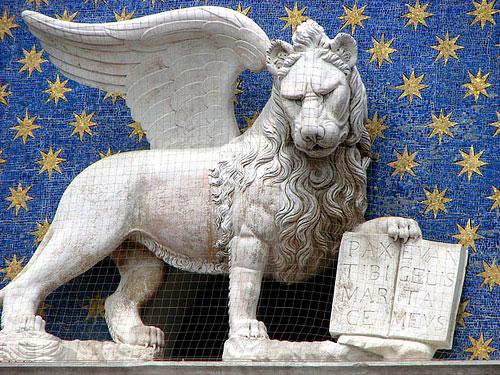The proud image of the lion is everywhere in Venice; gazing down from buildings, looking out from the keystone of an archway, or standing on fluted columns. The more you look, the more you see: no one knows how many there are.
Lions, and what they represented in terms of power and strength, were so important to the Venetians that centuries ago the nobility used to keep them captive in their gardens, and for a time the official state lion lived in a golden cage in the Piazza San Marco. He died, probably because he licked the bars of his cage and was poisoned by the gilding. Thereafter captive lions were forbidden, but the lion image continued in paintings, carvings, tapestries and frescoes.
For centuries Venetians were known as pantaloni (wearing trousers) but this may have originated from a corruption of pianta leoni (lion planters) because wherever they traded in the known world they “planted” their lion symbols, the winged lion being the symbol of St. Mark.
 The Venetian lion appears in two distinct forms. One is as a winged animal resting on water, to symbolise dominance over the seas, holding St. Mark’s Gospel under a front paw. You can see these mighty animals all round the Mediterranean, usually on top of a classical stone column. The other form, which is perhaps more interesting, is known as the lion “in moleca”, in the form of a crab. (Soft shell crabs are a local seasonal delicacy.) Here the lion is depicted full-faced with its wings circled around the head resembling the claws of a crustacean. It is emerging from water, so that the lion “in moleca” is associated with the lagoon and the city, whereas the standing winged lion is thought to be more associated with Venetian territory around the Mediterranean.
The Venetian lion appears in two distinct forms. One is as a winged animal resting on water, to symbolise dominance over the seas, holding St. Mark’s Gospel under a front paw. You can see these mighty animals all round the Mediterranean, usually on top of a classical stone column. The other form, which is perhaps more interesting, is known as the lion “in moleca”, in the form of a crab. (Soft shell crabs are a local seasonal delicacy.) Here the lion is depicted full-faced with its wings circled around the head resembling the claws of a crustacean. It is emerging from water, so that the lion “in moleca” is associated with the lagoon and the city, whereas the standing winged lion is thought to be more associated with Venetian territory around the Mediterranean.
Some lions were brought back from overseas territories as loot. (The same is also true of the remains of St. Mark himself.) There is a quartet of ancient lions outside the Arsenale, probably all with amazing stories to tell as they gaze out towards the lagoon.
 In Venetian paintings the lion sometimes appears not as a fierce animal, but as a gentle beast, tamed by man. Pietro Longhi painted one at the carnival with a dog on his back. In the Scuola di San Giorgio, Carpaccio depicts St. Jerome calmly leading his lion into a monastery. The lion follows obediently whilst all the monks flee away in terror.
In Venetian paintings the lion sometimes appears not as a fierce animal, but as a gentle beast, tamed by man. Pietro Longhi painted one at the carnival with a dog on his back. In the Scuola di San Giorgio, Carpaccio depicts St. Jerome calmly leading his lion into a monastery. The lion follows obediently whilst all the monks flee away in terror.
Wandering around the alleyways of Venice you might come across the stone faces of lions set into the walls of public buildings. These are mouths of truth, places where malicious Venetians could make an anonymous denunciation by posting a name into the lion’s mouth. Two witnesses were needed in order to bring a suspect to trial, but these were cruel times and punishments were harsh. In view of what damage the tourists are inflicting on Venice, it wouldn’t be a bad idea to denounce a few cruise ship companies right now.










